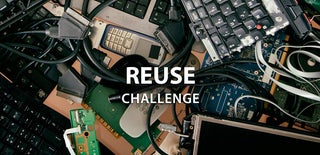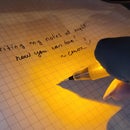Introduction: POP! Recycling Bubble Wrap to Fabulous Fabric!
Let's make bubble wrap fabric!
Being able to reuse, repair, and repurpose items is an essential way of thinking. When I saw the reuse challenge I thought it was a perfect place to show some of the upcycling, reusing, and repurposing ideas I've been working on.
Inspiration
This is inspired by a workshop run by Andrew Quitmeyer a year ago, where he demonstrated experimenting with materials. We looked at recycling plastics and cardboard, but one particular material stuck in my mind - bubble wrap!
Why?
Other than popping the bubbles, which is always fun, I try to save bubble wrap when I get it in packages and reuse it to send on packages. There is still always a pile of it left (is it growing?!). With this Instructable you'll see how we can repurpose bubble wrap and make it into a fabric that we can use to make other things!
Yes, you can sew with this fabric, and I've created an instructable for that too!
What's with the bling?
Also, because I'm a self-confessed geek, I've had to add bling to it - so I've embedded a string of RGB color LEDs (NeoPixels) inside the bubble wrap - this is our bling factor!
Please follow along as I demo how to make old, used, tired, bubble wrap into a funky, fabulous fabric we can sew with!
Supplies
For this Instructable you'll need the following 4 items:
- OLD, USED Bubble wrap! The star of the show - the more the better. This takes a lot of bubble wrap - which is great because we can repurpose large amounts of it. You can use any size of bubbles, the smaller ones or larger ones too.
- Access to a heat press, trouser press, or hot iron etc...
- Teflon sheets, this type of thing
- Any oven gloves or similar
Optional items:
Optional is a strip of RGB LEDs or similar to embed into your bubble wrap 'fabric'. You could add dried leaves and flowers, or other decorative items you have.
To complete the bling part you'll need:
- GEMMA M0 board
- 3 crocodile clips
- Arduino IDE to program the board
Let's get recycling!
Step 1: Preparation
First, let's prepare our materials. You might need to clean or cut out bits of bubble wrap if some of it is too damaged, dirty, or not possible to use.
This making fabric technique works well if you prepare the bubble wrap by cutting it into roughly all the same-sized squares. The squares we've cut are the size to fit a heat press. My colleague made a template so lots of squares could easily be cut.
I'm using a heat press at my local university. I haven't tried this with a hot iron, but a trouser press or hot iron will likely achieve similar results. But you do need a high temperature and a firm press for a sustained amount of time.
That's all the prep you need to do to make this unusual fabric from your waste bubble wrap. Let's see how to do it!
Step 2: Layer Up
With your precut sheets of bubble wrap prepared, layer them on top of your teflon sheet. You'll be making a teflon 'sandwich' (do not eat!) with the bubble wrap in the center of the 2 sheets.
You can see in the photos that we've layered up the bubble wrap.
From experimenting with this technique we've learnt:
- use about 6 sheets for a pliable 'fabric'
- using 9 sheets creates a more sturdy 'fabric'
Added Bling
- After adding sheets, I added a strip of RGB LEDs so they will be embedded into the bubble wrap 'fabric'
- If you want to embed something, choose what you want to add to your design, and add a few layers of bubble wrap on top to seal it between the layers.
When adding the RGB LED strip, be sure to drape the wires outside of the bubble area so you can connect them.
Step 3: Getting Hot!
Now set your machine up and try a few time and temperature tests.
This will vary from machine or process type, so I would recommend making a few smaller-sized test sheets, and making notes of what times and temperatures you used. you will quickly learn what works best for your machine.
- carefully put the Teflon sheet and bubble wrap sandwich into your machine
- make sure the ends of wires if you are using the RGB LED strip are hanging outside of the machine
- set your time and temperature
- press down firmly and wait
We played around with temperature a lot initially, and we ended up waiting around 5 minutes to create a good bond between the bubble wrap layers.
When it's finished heating - it should be ready.
Step 4: Ding! It's Ready!
After waiting and getting the correct temperature, your bubble wrap 'fabric' will be ready! WOOP well done.
Be Careful!
This is super hot! We used silicone mittens to hold the Teflon sheets carefully when removing them from the heat press.
- using gloves remove the Teflon sheet package from your press
- carefully and slowly, peeling back the top layer of Teflon sheet
- you should now be able to peel off the bubble wrap fabric from the bottom layer of Teflon sheet too
I've shown some photos of a few experiments we did with this technique. Different numbers of layers give different opacity for the 'fabric'. You could add colour between the layers, or even use coloured bubble wrap that you might have.
The last two photos show the various thickness and pliability of the different numbers of layers of bubble wrap. Too thin and it becomes a little too fragile to use but too thick and it's also too firm for sewing - though would make a great liner for sewing items such as handbags that need a reinforced bottom.
If your layers of bubble wrap separate, reheat them to make a firmer bond between them or increase the temperature.
Step 5: Adding the Bling
If you are interested in the bling factor - then after you have your completed fabric piece with embedded RGB LEDs, you will need to connect it to a microprocessor board. I've used the lovely Gemma M0 board from Adafruit because it's great for making wearables and has a small size and a number of pins for this circuit.
Hookup
To complete this part you'll need:
- GEMMA M0 board
- 3 crocodile clips
- Arduino IDE to program the board
The LED strip takes 3 wires:
- ground
- power
- data
Using the croc clips:
- connect power on the GEMMA M0 --> VIN on the LED strip
- connect ground on the GEMMA M0 --> GND on the LED strip
- connect D1 on the GEMMA M0 --> DIN on the LED strip
Then, connect your GEMMA M0 to your computer and open ARDUINO.
Adding the Code
Search for and Install the NeoPixel library from Adafruit. Once it is installed, go to File | Examples | Adafruit NeoPixel and select the RGBWStrandtest example.
You'll only need to change 2 variables in this code:
At the start of the code look for:
// Which pin on the Arduino is connected to the NeoPixels?
// On a Trinket or Gemma we suggest changing this to 1:
#define LED_PIN 1
// How many NeoPixels are attached to the Arduino?
#define LED_COUNT 17
For my circuit, I changed the pin to reflect that I am using digital pin 1 on the GEMMA M0
Also, my strip of LEDs has 17 LEDs in it. Alter this to suit the number of LEDs in the circuit.
After editing the code, check your board and port are correctly selected (in the Tools menu), and then upload the code.
BLING!!! It should now be working! Enjoy your recycling and blinging.
I hope you had fun learning about a new way to make a useful fabric.
Step 6: Now Make Something With Your Fabric - How About a Bling Bag?
You can also follow on to my other Instructable that shows using this unique fabric to make a bag to hold your items, such as pens, pencils, or other small things to carry with you.
Yes, you can sew a bling conductive touch bag with this fabric, and I've created an instructable for that too!
--------- thanks ----------
To see more of my projects and wearables, visit http://christinefarion.com, follow me on Instagram, and Twitteris useful if you have any questions or comments!

Runner Up in the
Reuse Challenge













